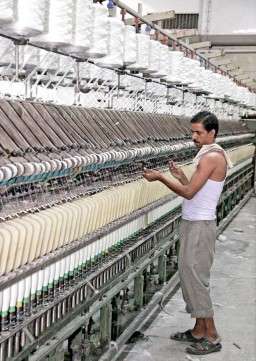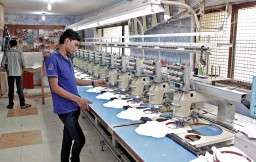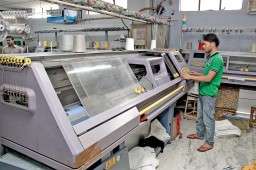
Kidswear, though an under-explored product category for Ludhiana, still does not have many takers and the companies who are into this business are not necessarily by choice, but by natural turn of events; however they are all reaping the benefits of working in this category. The intricacies involved in the kid’s segment which includes a lot of value addition, handling small fabric, taking extra care towards using dyes, and meeting safety norms, are some of the deterrents in the growth of kidswear manufacturing in Ludhiana. The five companies that were visited by Team StitchWorld, all had in-house fabric knitting, printing and embroidery, to give variety to products and to keep the costs in check.
Since Superkids and Nagesh Knitwears are working with sweaters, both have state-of-the-art Stoll machines. Hand flat machines are also in use as they prove to be more cost-effective in producing certain fabric structures like intarsia. Nagesh Knitwears has recently experimented in working with heavier gauge fabric in sweaters and is currently projecting it as their design edge. Jagdambay Exports and Paramount Clothing are mainly into circular knitted fabric products, and both the companies are entirely self-sufficient in their fabric needs. Apart from Nagesh Knitwears, none of the companies have a spinning unit, and yarns are being sourced mainly from the local market and in some cases from China/Taiwan as well.


Though these companies are doing good volumes and generating decent turnovers, none of the companies boost of any management or technological prowess in its working. Only Jagdambay Exports follows an assembly line system in sewing, while the other three companies manufacture garments in batches, this being attributed to attaining certain level of turnover before starting assembly line system. The machines in batch system have been placed according to the type of machine, and the bundle moves from an operator from one group working with lockstitch machines to another group working on overlock machines. Thereafter, the bundle goes for button holing and button attaching, and then finally moves to the finishing section. Jagdambay Apparels and Nagesh Knitwears have specialized snap attaching and tape attaching machines too.
While all the companies do 100% metal detection, use azo-free dyes and nickel-free buttons, Nagesh Knitwears even performs tests like snap and button pulling. Expectedly, the sewing in all the companies is being done on a piece-rate system, while other departments have salaried employees. It is because of the shortage of workers and hence their dominance. The fact that sewing room works on piece rate, with no fixed operators, makes it difficult to plan and manage the production in a assembly line, as absence of few disrupts the entire line balancing.
[bleft] Our Production Capacity
Superkids and Ziama Fashions are domestic players, with modest setups, producing 800 pieces and 3000 pieces per day, respectively, with Ziama Fashion outsourcing most of its sewing to outside vendors.
Paramount Clothing, doing both exports and domestic, is producing around 8,000 pieces per day of kidswear and menswear T-shirts, together from its cluttered units in the city.
Jagdambay Exports can make 10,000 pieces of baby body suits or 5,000 pieces of baby sleep suits or 30,000 pieces of baby pop over bib per day .[/bleft]
Increasing productivity may not be the target for now, but reducing wastages surely is. Jagdambay Exports and Nagesh Knitwears stress on in-line checking, with Jagdambay Exports employing trained personnel from ATDC to ensure the quality. The idea is to minimize the movement of product from one department to another and back.
To remain price-competitive against rivals from Bangladesh or China, companies in Ludhiana are giving more attention to the cutting room. But for now, only Nagesh Knitwears is running a Lectra CAM system for efficient marker making while the other four companies are all now planning investment in CAD/CAM.
However, presently the cutting and pattern making in the four companies remains predominantly manual. With no marker preparing mechanism, the patterns are traced directly on the top ply of the lay, and the efficiency of the marker totally depends on the experience and accuracy of the operator. There again, for controlling wastage, the cut parts have to go through 100% inspection before they are sent to different departments, like screen printing or embroidery, for preparation. Upon return, they are again checked 100% and bundles are made.
With increasing top lines and decreasing bottom lines, few of the companies are feeling the need to involve consultants for streamlining their processes.

Post a Comment